Brush-tailed Phascogale
Brush-tailed PhascogalePhascogale tapoatafa tapoatafa | |
|---|---|
| Kingdom: | Animalia |
| Phylum: | Chordata |
| Class: | Mammalia |
| Order: | Dasyuromorphia |
| Family | Dasyuridae |
| Sub-Family: | Phascogalinae |
| Status | |
| Australia: | Vulnerable; not listed (EPBC Act 1999) |
| Victoria: | Vulnerable (FFG Threatened list 2025) |
| FFG: | Listed; Action statement No. 79 |
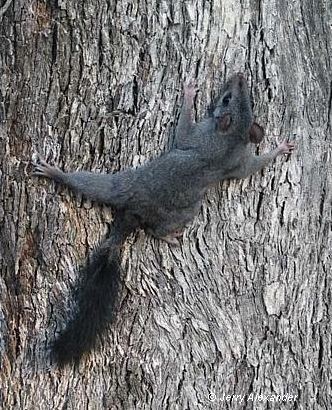
Brush-tailed Phascogale.
Image: Jerry Alexander
The Brush-tailed Phascogale (Phascogale tapoatafa tapoatafa), also known as the Tuan, is a small, nocturnal, arboreal, carnivorous marsupial. It is a uniform deep grey on the head, back and flanks, light grey to pale cream underneath with large naked ears and a conspicuous, black 'brushy' tail.
Distribution
There are two sub-species of Brush-tailed Phascogale in Australia:
- Phascogale tapoatafa tapoatafa, occurrs in southern Australia,
- Phascogale tapoatafa pirata, occurrs in northern Australia.
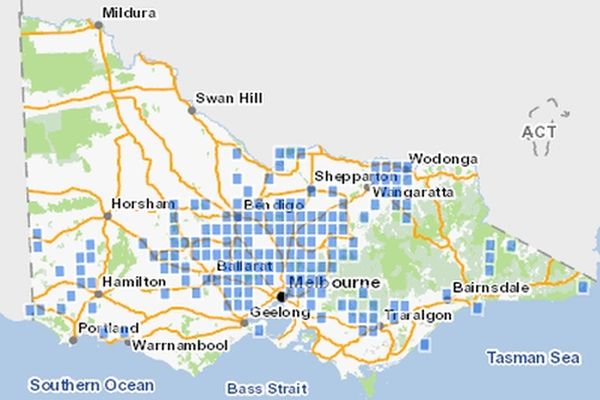
In Victoria, the Brush-tailed Phascogale now has a fragmented distribution, to the east and north-east of Melbourne, central Victoria around Ballarat, Heathcote and Bendigo; north-eastern Victoria from Broadford to Wodonga; the Brisbane Ranges north-east of Geelong; and far western Victoria from Mt Eccles to Apsley.
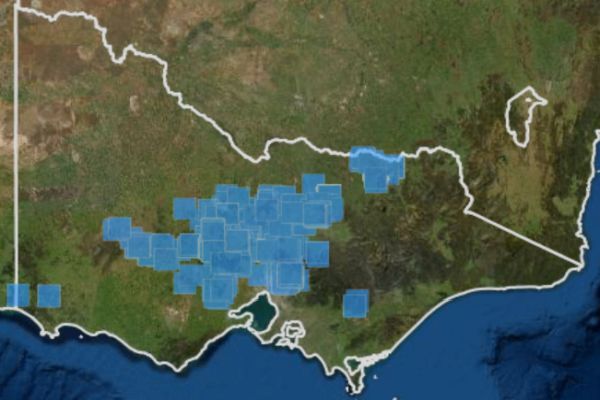
Ecology & Habitat
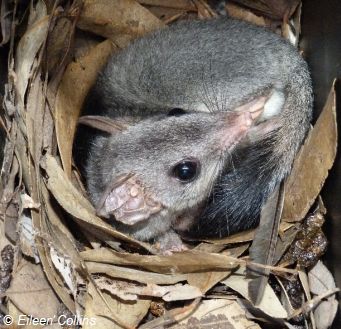
Source: Eileen Collins
The Brush-tailed Phascogale inhabits open dry foothill forest with little ground cover, typically associated with box, ironbark and stringybark eucalyptus.
The Brush-tailed Phascogale is a shy, cryptic species that occurs in low densities and forages over a very large home range (female 20–70 ha, males 100 ha) which means only small populations can exist in quite large areas of habitat.
Brush-tailed Phascogales are primarily arboreal, and forage for their diet, which is predominantly large insects, spiders and centipedes, on the trunks and major branches of rough-barked eucalypt trees, fallen logs and amongst litter on the forest floor. Eucalypt nectar may be taken when ironbarks or boxes are flowering.
Hollows in dead or live trees provide preferred den sites, although nests constructed under flaking bark, or in tree stumps are sometimes used but provide a less secure substitute against predators in areas where hollows are scarce. Mating occurs in late autumn - early winter and males die after the breeding season at an age of about one year old. Females give birth to about six young from mid June to early August.
Threats
Clearing and fragmentation of preferred habitats combined with changes to the forest structure through timber and firewood cutting, grazing and previous gold mining has impacted upon habitat values. A reduced abundance of hollows limits breeding opportunities and increases exposure to predation from foxes and cats.
Loss of dead trees in the landscape is an issue because dead trees comprise an important component of phascogale habitat with animals spending about 80% of their time using dead trees. (SWIFFT seminar notes talk by William Terry)
The loss of hollow-bearing trees from Victorian native forests has been listed as a potentially threatening process on Schedule 3 of the Flora and Fauna Guarantee Act 1988, largely because of the dependence of many vertebrates (including a number of rare species) on this habitat for shelter and nesting.
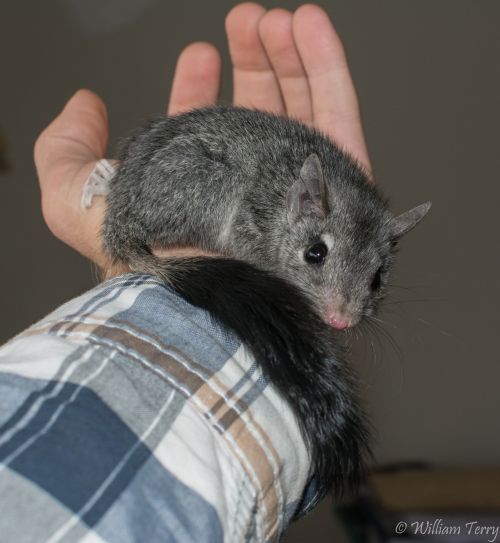
Conservation & Management
Management measures for conservation of the Brush-tailed Phascogale in Victoria
At all known Brush-tailed Phascogale sites, planning for prescribed burning operations must ensure that where prime Phascogale habitat is identified it is not destroyed.
South West Victoria
Priority Local Government Areas: City of Greater Geelong, Moorabool Shire, Southern Grampians Shire, Ararat Rural City, Hepburn Shire, Pyrenees Shire.
Priority locations South West Victoria:
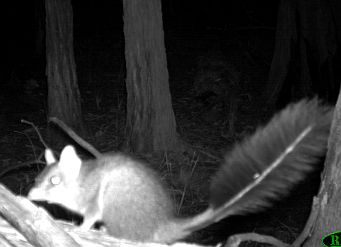
taken with remote camera.
Source: Wombat Forestcare
Brisbane Ranges National Park- surveys in Meredith to Steiglitz area to determine current status. Geelong Field Naturalists Club has been assisting with surveys since 2007. Parks Victoria undertakes fox control in areas where Phascogales are found. Friends of Brisbane Ranges phascogale project conducts nest box installation and monitoring.
Clunes State Forest and Dunach Nature Conservation Reserve - it is proposed to conduct 3 surveys over 10 year period commencing in 2012/2013 and follow up in 2015/16 and 2018/19. There is a need to ensure post and firewood collection does not impact on Phascogale habitat.
Grampians National Park - assess possible sites for future surveys.
Hepburn Regional Park - monitor and control Feral Cat population. Phascogale surveys are carried out every year as part of a long term monitoring program.
Lal Lal - Bungal Historic Area - need to determine suitable survey area.
Mount Beckworth Scenic Reserve - this is a priority area for long term surveys.
Mt Buangor State Park (North West section) - 3 surveys to be conducted over 10 years.
Mt Cole Forest - 3 surveys to be conducted over 10 years.
Percydale Historic & Cultural Features Reserve - further surveys required.
Pyrenees Forest (Warrenmang) - further surveys required.
Ararat Regional Park (Dunneworthy) - conduct 3 surveys over a 10 year period, every 3-4 years.
Trawalla State Forest - poor results from hair tube survey but further survey required.
Wombat Forest (Glenlyon & Trentham) - identify suitable areas before any further surveys.
Wombat Forest (Yandoit) - considered to be an important area with regular surveys being conducted.
North East Victoria
Priority Local Government Areas: Moira Shire, Indigo Shire, Strathbogie Shire, Murrindindi Shire, Mansfield Shire, Benella Rural City
Priority locations in North East Victoria
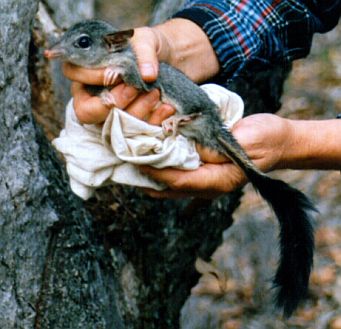
to assess their condition and released
back into the wild. Source: Andrew Arnold
Barmah State Park - conduct a survey to determine presence and extent of the Phascogale population.
Beechworth Historic Park - ensure records of sightings included in Victorian Biodiversity Atlas.
Chiltern Box-Ironbark National Park - planning to develop appropriate burning regime to ensure Phascogale conservation in prescribed burns was started in 201/12. Parks Victoria will carry out an ongoing fox control program with monitoring.
Roadsides managed by Strathbogie Shire and Vic Roads - conserve roadside habitat by restricting or discourage access, particularly when undertaking roadworks in areas where Phascogales are known to exist.
Eildon National Park ( Jerusalem Inlet and Woolshed Inlet) - previous surveys have failed to record any phascogales at Jerusalem Creek despite suitable habitat being present but further surveys are required. Phascogales previously recorded at Woolshed Creek in 2005.
Mount Samaria State Park - ongoing nest box and hair tube surveys.
Mt Pilot Multipurpose Park - annual surveys conducted, Fox and Feral Cat control being implemented along with improving habitat on adjoining land.
Puckapunyal Army Reserve - ongoing monitoring in conjunction with Department of Defence.
Reef Hills State Park - this is priority area with regular surveys. A kangaroo management plan is being implemented to reduce overgrazing and degradation of ground cover.
Strathbogie State Forest - considered an important area for surveys and management.
North Central Victoria
Priority Local Government Areas: Greater Bendigo City, Loddon Shire, Mount Alexander Shire.
Priority locations in North Central Victoria: In 2009/10 a report was completed by Bennett et.al. which looked at population trends and characteristics across the Phascogales range, including the following sites.
- Bendigo Regional Park' (Mandurang)
- Dunolly Nature Conservation Reserve
- Greater Bendigo National Park
- Heathcote-Graytown National Park
- Eppalock Education Area
- Kooyoora State Park
- Wellsford State Forest
- Maldon Historic & Cultural Features Reserve
- Paddys Ranges State Park
- Pilchers Bridge Nature Conservation Reserve - planning underway to involve community groups in management and monitoring. Further work is planned to analyse genetic data and prepare a report.
During 2013/14 it is hoped progress will be made to establish a Conservation Management Network for the Mandurang area focusing on management of Phascogale on private land and surrounding public lands.
Improved fire management prescriptions are being developed to ensure that populations of Brush-tailed Phascogale remain viable in the Bendigo Regional Park, this will focus on reducing the frequency and intensity of prescribed burning in the Park.
Increasing habitat linkages between priority management areas is required to maintain a viable population.
The Bendigo Field Naturalists Club - nest box project is a significant project aimed at conservation of phascogales in the Bendigo Regional Park area.
North West Victoria
Key Local Government Areas: Northern Grampians Shire.
Priority locations in North West Victoria:
- Dalyenong Nature Conservation Reserve - populations trends analysed in 2009. There is a need to ensure known populations are protected from prescribed burning.
- Kara Kara National Park
- Mount Bolangum Nature Conservation Reserve
Port Phillip catchment
Priority Local Government Areas: Nillumbik Shire.
Priority locations in Port Phillip area:
- Warrandyte-Kinglake Nature Conservation Reserve and Kinglake National Park.; Parks Victoria undertakes annual surveys in this area. This is a long running program which has been conducted for the past 20 years and forms part of the monitoring co-ordinated through the State-wide Brush-tailed Phascogale working group.
- Warrandyte State Park; there is no formal monitoring of Brush-tailed Phascogales in the park but any sightings are welcome. Friends of Warrandyte State Park have been involved in a nest box program which are periodically monitored.
- Kinglake/Warrandyte Habitat Link - this is a high priority area for on-going monitoring of Phascogales. Monitoring post fire recovery of habitat in Kinglake National Park. Artificial nesting hollows are being installed in key areas of the Kinglake Warrandyte Habitat Link. Control of Foxes, Feral Cats and environmental weeds are carried out in this area. More details (pdf).
See also: Brush-tailed Phascogale images from this project.
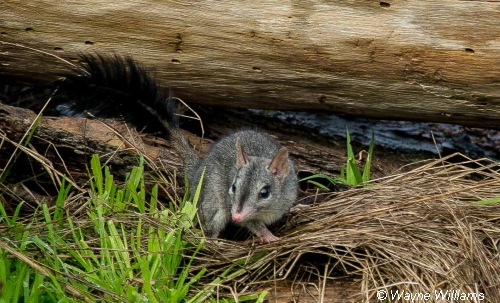
Brush-tailed Phascogale video recorded with infra-red motion sensing camera by Christmas Hills Landcare Group, March 2013.
Projects & Partnerships
The Brush-tailed Phascogale Project - Friends of Brisbane Ranges
The project aims to investigate the effect of the number of hollow bearing trees on the incidence of threatened arboreal mammals and to determine the impact of control burns. The benefit of replacing tree hollows with nesting boxes will also be investigated.
Bendigo Field Naturalists Club - nest box project
This long-term project has been operating for the last 30 years (c. 1986-2016) the Bendigo Field Naturalists Club has been placing nest boxes throughout the bushland parks and reserves surrounding the City of Greater Bendigo. Nest boxes that target the Brush-tailed Phascogale have been installed to restore hollow availability in forest areas where past disturbance has caused coppice regrowth of small multi-stemmed trees that lack natural hollows. Boxes have been maintained and monitored by the club over this period. Current trials & research.
Research project 2017
William Terry, Southern Cross University, is currently completing a PhD on the conservation of Brush-tailed Phascogale in central Victoria titled ‘Managing the potential impacts from development and urbanisation on the threatened Brush-tailed Phascogale (Phascogale tapoatafa), in the modified landscape of central Victoria. This research will investigate effective nestbox designs, barriers that impede dispersal, impact of fire and mitigation of other threats. Contact 03 5421 9674 or e-mail
Partnerships
Key partners in conservation of the Brush-tailed Phascogale include; Department of Environment and Primary Industries (DEPI), Parks Victoria, University of Melbourne. University of Ballarat, Friends of Brisbane Ranges, Geelong Field Naturalists Club, Field Naturalists Club of Victoria and Strathbogie Shire. A number of Landcare and Conservation Groups also undertake passive monitoring using remote cameras.
The Brush-tailed Phascogale Coordinating Group (BtPCG) has been meeting and coordinating the implementation of the Brush-tailed Phascogale Action Statement (FFG Act) since 1997. The BtPCG is not a recovery team per se, but essentially a working group that coordinates management actions that occur within a variety of woodland and dry forest ecosystems across the State. Since 2000, members of the BtPCG have been conducting systematic monitoring of a selection of the 40 Priority Management Areas, identified in the Action Statement, using the Brush-tailed Phascogale as a ‘focus’ species.
The long-term monitoring data have been analysed and published in an international journal. Holland G. J., Alexander J. S. A., Johnson P., Arnold A. H., Halley M. and Bennett A. F. (2012). Conservation Cornerstones: Capitalising on the endeavours of long-term monitoring projects. Biological Conservation 145: 95 – 101.
Long-term research into nest box design, installation and management of woodland areas to support small arboreal mammals such as the Brush-tailed Phascogale and Sugar Glider are being carried out by the Bendigo Field Naturalists Club (K. Thomas) and Southern Cross University (R. Goldingay).
Research findings
Comparing the thermal suitability of nest-boxes and tree-hollows for the conservation-management of arboreal marsupials Rowland, Jessica & Briscoe, Natalie & A. Handasyde, Kathrine. (2017). . Biological Conservation. 209. 341-348. 10.1016/j.biocon.2017.02.006. Abstract on ResearchGate.
Tolerance to high temperature by arboreal mammals using nest boxes in southern Australia (May 2021) - Research into the thermal properties of nest boxes was carried out to determine temperature profiles in extreme temperatures >40C, <0C using various types of nest box materials and designs i.e. PVC pipe, foamed PVC boxes, wooden/ply boxes, natural log hollows. Results found that although nest boxes have poor insulative properties compared with natural hollows the high temperatures in nest boxes did not result in mortalities but could potentially cause heat stress in summer. It is recommended that nest boxes be designed to minimise summer heating. Full report: Tolerance to high temperature by arboreal mammals using nest boxes in southern Australia. Ross L. Goldingay, Karen J. Thomas. Journal of Thermal Biology, Vol. 98 May 2021.
Temperature variation in nest boxes occupied by arboreal mammals during winter in southern Australia (May 2022) -This research focused on studying the temperature loss in nest boxes during the winter months for Brush-tailed Phascogales and Sugar Gliders. Nest boxes were made of 18 mm thick timber (ply, hardwood or pine) and measured 15–25 × 15–25 wide and 30–45 cm tall with an entrance hole of 3.5–4.5 cm diameter.
In particular, for Brush-tailed Phascogales which contained nestlings, the nest temperatures in the box declined to 3°C of ambient within 4 hours of the mother’s departure. In order to prevent the nest temperature dropping too low the female would return to the nest 1 to 3 times during the night. This research shows that nest boxes have a place if used correctly in recovering forests. Full report: Temperature variation in nest boxes occupied by arboreal mammals during winter in southern Australia Ross L. Goldingay and Karen J. Thomas, Australian Mammalogy https://doi.org/10.1071/AM21049
Managing the threatened Brush-tailed Phascogale in the modified landscape of central Victoria. PhD by William Terry, Supervised by Ross Goldingay Southern Cross University. View notes from talk to SWIFFT Seminar by William Terry.
Habitat preferences of arboreal mammals in box-ironbark forest during maternal and non-maternal periods Ross L. Goldingay A, Darren G. Quin A and Karen J. Thomas B. Australian Mammalogy 46, 2024, CSIRO Publishing https://www.publish.csiro.au/am/AM24010
References
FFG Threatened List (2025) Flora and Fauna Guarantee Act 1988 - Threatened List - March 2025, Department of Energy, Environment and Climate Action (DEECA) , Victoria.
More Information
- Brisbane Ranges Brush-tailed Phascogale Project
- Bendigo Field Naturalists Club nest box project
- Victorian Flora & Fauna Guarantee Action Statement No.79 (pdf)
- Brush-tailed Phascogale Long Term Monitoring - pdf
- Observations - images of Brush-tailed Phascogale
- Brush-tailed Phascogale - nest box clip from interstate experience
Searching for the Brush-tailed Phascogale in the northern part of the Wombat Forest, April 2010. Narrated by Andrew Arnold, Snr. Biodiversity Oficer, DEPI, Ballarat.

